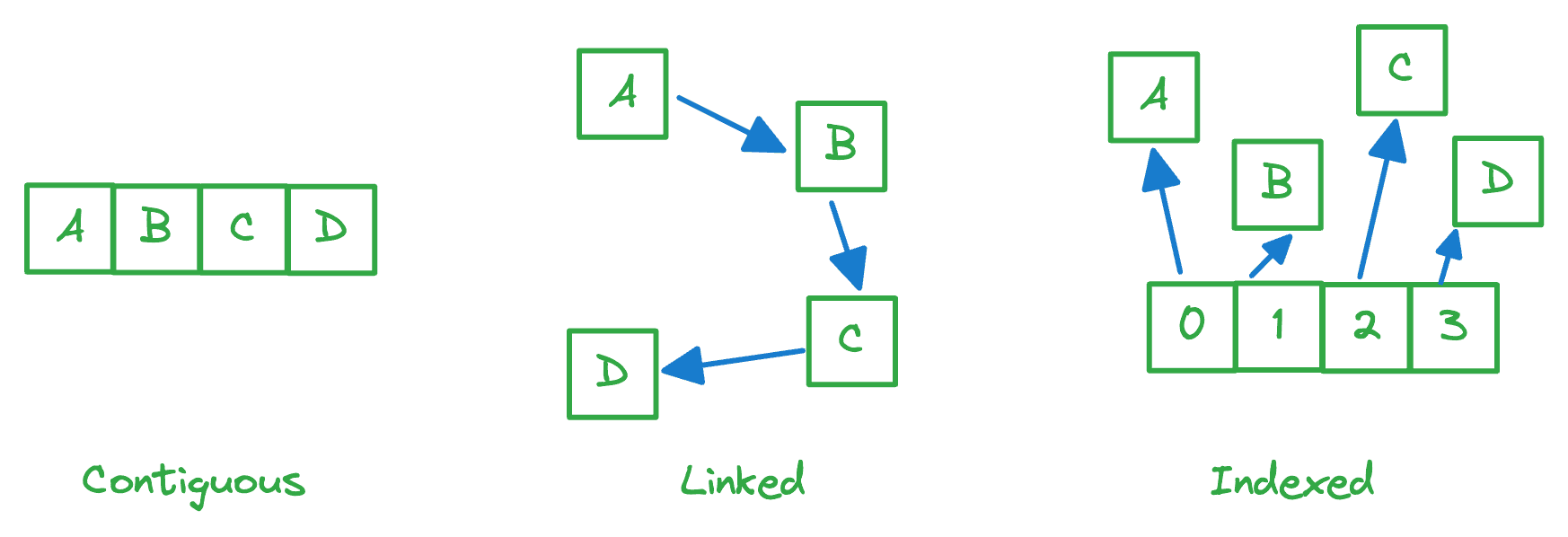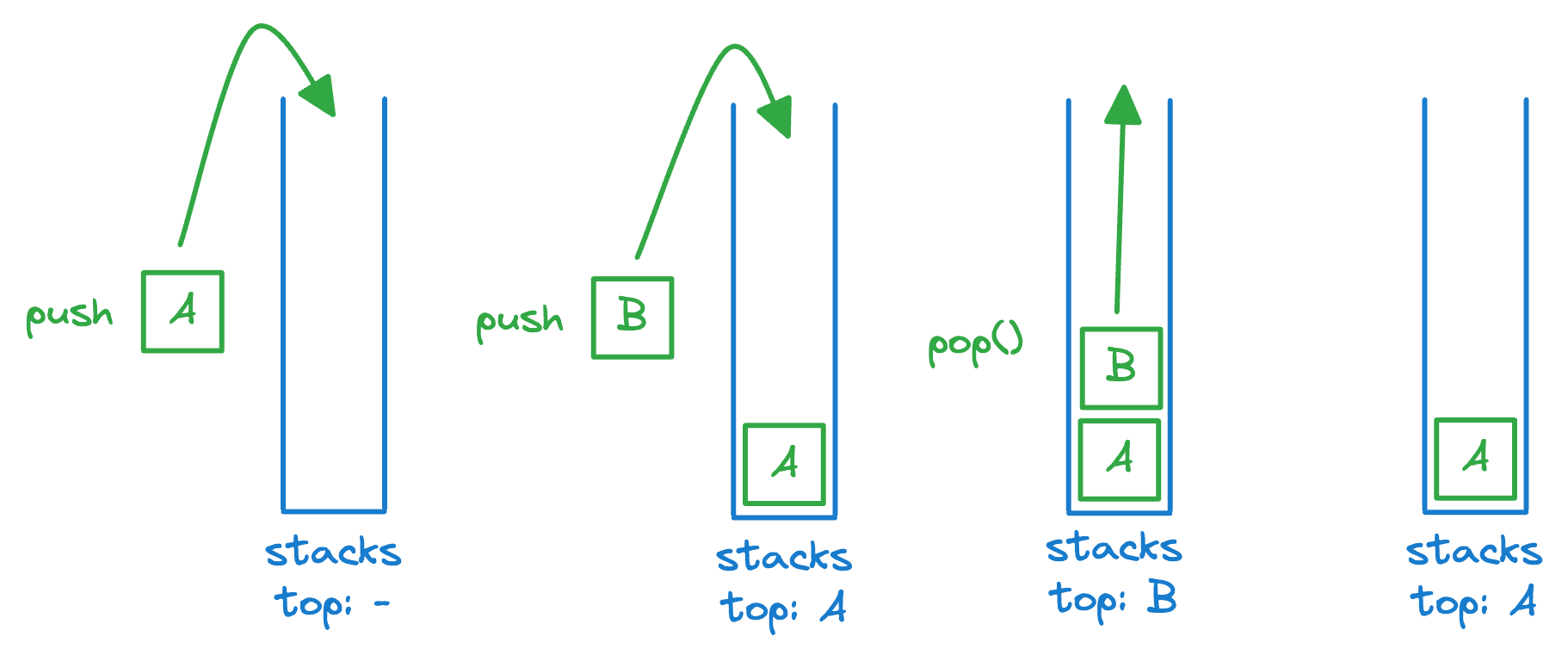Data structure เนื้อหามิดเทอม 2566/1
August 31, 2023
Table of Contents
- Why should we learn Data structure?
- Chapter 1 Data structure
- Chapter 2 Stacks
- Chapter 3 Queue
- Chapter 4 Linked list
- Chapter 5 Hash table
Why should we learn Data structure?
- I have a data, what data structure can it represent
- Definition, Draw, Explain
- How can i input that data to its structure
- How can i process that data for wanted result
Chapter 1 Data structure
Type of Data structure
- Primative data structure: Anything with single value
- Non-primative
- Linear: array, linked list, stack, queue
- Non-linear: tree, graph
Memory allocation

- Contiguous
- An array stores n objects in a single contiguous space of memory
- Linked
- The object itself, and
- A reference to the next item
- Indexed
- An array of pointers
Type of problems
- Non computable Problem – It can not be transformed into mathematic function.
- It can not be used computer to solve this type of problem.
- Computational Problem – can be transformed into mathematic function.
- We can use computer to solve this type of problem.
Complexity
- Space complexity: Amount of memory space
- Time complexity: Analysis performance of run time
Landau Symbols คือ Big O Notation
Chapter 2 Stacks

What is a stack?
- Last-In-First-Out (LIFO)
- Uses a explicit linear ordering
- Insertions and removals are performed individually
- push: Inserted objects are pushed onto the stack
- top: The top of the stack is the most recently object pushed onto the stack
- pop: When an object is popped from the stack, the current top is erased
Constructor and Destructor
- Constructor: Run when object is created
- Destructor: Run when object is removed or not used
class Stack { public: Stack() { // Constructor } ~Stack() { // Destructor } };
Stack Implementations
-
Using array
- For one-ended arrays, all operations at the back are
class Stack { private: int arr[10]; int top_idx = 0; public: bool empty() { return top_idx == 0; } int top() { return arr[top_idx - 1]; } void push(int val) { arr[top_idx] = val; top_idx += 1; } void pop() { top_idx -= 1; } } -
Using Linked list
class Node { public: char val; Node* next; }; class Stack { private: Node *head = NULL; public: void push(char val) { // Insert First Node *new_node = new Node(); new_node->val = val; new_node->next = head; head = new_node; } bool empty() { return head == NULL; } void pop() { // Delete First Node *tmp = head; head = head->next; delete tmp; } char top() { return head->val; } }; -
Using C++ STL library
#include <iostream> #include <stack> using namespace std; int main() { stack<int> mr_stack; mr_stack.push(21); mr_stack.push(25); mr_stack.push(17); mr_stack.pop(); while (!mr_stack.empty()) { // 25 21 cout << mr_stack.top() << " "; mr_stack.pop(); } return 0; }
Stack Applications
- Parsing code:
- Matching parenthesis
- XML (e.g., XHTML)
- Tracking function calls
- Dealing with undo/redo operations
- Reverse-Polish calculators
- Assembly language
- ปัญหาอะไรก็ตามที่
- ทำแล้วเจอปัญหาย่อย
- เมื่อปัญหาย่อยเสร็จต้องกลับไปทำปัญหาเดิม
- Fucking Reverse-Polish Notation
Chapter 3 Queue
What is a queue?
- First-In–First-Out (FIFO)
- enqueue: Inserted objects are pushed onto the queue
- dequeue: The top of the queue is the least recently object (oldest) pushed onto the queue
- top หรือ front: The top of the queue is the least recently object (oldest) pushed onto the queue
Queue Implementations
-
Using array
class Queue { private: int arr[10]; int front_idx = 0; int back_idx = 1; int queue_count = 0; public: bool empty() { return queue_count == 0; } int top() { return arr[front_idx % 10]; } void enqueue(int val) { queue_count += 1; arr[(back_idx - 1) % 10] = val; back_idx += 1; } void dequeue() { queue_count -= 1; front_idx += 1; } }; -
Using Linked list
class Node { public: int val; Node *next; }; class Queue { public: Node *head; void enqueue(int val) { // Insert last Node *new_node = new Node(); new_node->val = val; new_node->next = NULL; if (head == NULL) { head = new_node; } else { Node *tmp = head; while (tmp->next != NULL) { tmp = tmp->next; } tmp->next = new_node; } } void dequeue() { // Removed first Node *tmp = head; head = head->next; delete tmp; } int top() { // First position return head->val; } bool empty() { return head == NULL; } }; -
Using C++ STL library
#include <iostream> #include <queue> using namespace std; int main() { queue<int> mr_queue; mr_queue.push(10); mr_queue.push(20); mr_queue.push(30); mr_queue.pop(); while (!mr_queue.empty()) { // 20 30 cout << mr_queue.front() << " "; mr_queue.pop(); } return 0; }
Queue Applications
- อะไรที่ต้องรอคิว
- Breadth-first traversal in Binary Tree
Chapter 4 Linked list
- A linked list is a data structure where each object is stored in a node
- As well as storing data, the node must also contains a reference/pointer to the node containing the next item of data
class Node { public: char val; Node* next; };
Static Allocation vs Dynamaic Allocation
// Static Allocation int f() { // Object is created in the local scope in the func Node new_node; new_node.val = 555; cout << new_node.val << endl; // After the function is return // C++ Will call class destructur and destroy new_node (which is local variables) 🎇🎇 return 0; } // Dynamaic Allocation int f2() { Node *new_node = new List(); new_node->val = 555; cout << new_node->val << endl; // After the function is return // The object will still be in the memory F O R E V E R return 0; }
Linked list Operations
- Insert into
- Access
- Erase from
ผมแนะนำให้เพื่อนหยิบปากกามาวาดทีละขั้นตอนว่าควรทำอะไรก่อนอะไรหลัง เดินตามเส้น Pointer ไปเรื่อยๆ เพื่อไม่ให้เส้นขาด เทคนิคก็คือส่วนมากมักจะแก้ที่ Node ใหม่ก่อน สู้ๆ ครับ ^ ^
Doubly linked list
class Node { public: char val; Node* next; Node* prev; };
Chapter 5 Hash table
Searhing
- Linear Search: search data in linear data structure
- Sequential Search: หาทีละอัน
- Binary Search: ทาทีละครึ่ง
- Index Sequential Search: หาตามกลุ่ม
- เช่น สารบัญ เรื่องเกี่ยวกับ ... อยู่หน้า 12 - 42
- Hash Search
What is a hash table?
- Hash table หรือเรียกอีกอย่างว่า Hash map เป็น Data structure ที่สามารถเชื่อมค่า Key ไป Value ได้
- Hash table ใช้ Hash function เพื่อคำนวนสื่งที่เรียกกว่า Index (หรือ Hash code) เพื่อนำไปเป็น Index ใน Array ทำให้สามารถเก็บ / ดึงค่าออกมาได้
- ระหว่างการหาค่าใน Hash table, Key จะถูก Hashed และผลลัพท์ของ Hashed Key จะนำไปสู่ตำแหน่งของ Value ได้
- รวม Code ของ Hash table
Hash function
- Direct Hashing
- นำ Key มาเป็น Index index = key;
- Subtract Hashing
- นำ Key มาลบด้วยบางค่า index = key - SUBTRACT;
- Digit-Extraction Hashing
- ใช้บางส่วนของเลขมาเป็น index
- เช่น ใช้ตำแหน่งที่ 1, 5, 9 จะได้
- Mid Square Hashing
- นำ Key มากำลังสองและเอาค่าตรงกลางของผลลัพท์มาเป็น Index
- เช่น
- Fold Shift Hashing
- แบ่ง Key ออกเป็น 3 ส่วน (a, b, c)
- เอามารวมกันแล้ว mod HASH_SIZE
- index = (a + b + c) % HASH_SIZE;
- Fold Boundary Hashing
- แบ่ง Key ออกเป็น 3 ส่วน (a, b, c)
- reverse เลขซ้าย และ เลขขวา
- index = (reverse(a) + b + reverse(c)) % HASH_SIZE;
- เช่น
- Modulo-Division Hashing
- นำ Key มา mod ด้วยขนาดของ Hash table index = key % HASH_SIZE;
Collision
- การที่คนละ Key กันแต่หลังจาก Hash function ออกมา Index มีค่าเท่ากัน
- จึงมีเทคนิคการหลบลีกค่าดังนี้
- Seperate chaining
- เป็นการสร้าง Hash table ด้วย Array ของ Linked list
- ถ้าหากมี Index ที่ซ้ำกันก็แค่ Insert last ของ Linked list นั้นไปเรื่อยๆ
- Open Address
- Linear probing
- เมื่อเกิดการ Collision ขึ้นจะเลื่อนตำแหน่งทีละ ไปเรื่อยจนกว่าจะเจอพื้นที่ว่าง / เจอค่า
- Quadratic probing
- เมื่อเกิดการ Collision จะเพิ่มตำแหน่งทีละ โดยที่ คือจำนวนครั้งที่เกิดการ Collision ในการหานั้นๆ
- Double hashing
- โดยที่ มักจะเขียนว่า "Hash table สมมุติ"
- Linear probing
- Seperate chaining